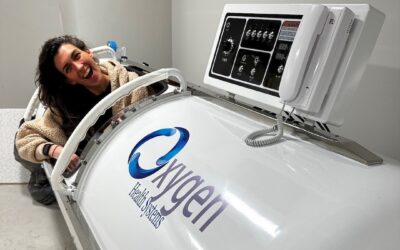From computer screens and smartphones, to e-readers and televisions, we all get our fair share of screen time. And thanks to these technologies, we live in a time when we have the ability to be more connected than ever. However, as helpful as these devices may be, it turns out that staring into them all day may pose notable health risks.
Everyday we are significantly increasing our exposure to blue light (also known as “junk light”) through our electronics. Too much exposure to this type of unnatural light can begin to take a toll on not only our eyes, but our overall health. And it turns out that screens aren’t the only source of this junk light. In fact, the fluorescent lights and white LED light bulbs at your home and office also contain considerable amounts of blue light.
Light can be both a medicine and a poison. This is because different light frequencies send different signals to our bodies, affecting our mitochondria. Our eyes contain the third highest concentration of mitochondria in the body, right after the brain and heart. When our eyes are exposed to unnatural spectrums of light, such as artificial blue light, it wreaks havoc on your mitochondrial energy production resulting in:
- Mitochondria stress and damage
- Increased free radical damage
- Decreased energy production
- Eye damage
- Disrupted circadian rhythm
- Disrupted sleep
- Premature skin aging
Why does blue light affect mitochondria?
It all comes down to evolution. We have simply not evolved to process this artificial junk light, and because of this our mitochondria has to work overtime to process it. This causes free radical damage and inflammation to not only our eyes, but also in the brain and other vital organs.
When the sun goes down at night, our bodies begin to produce more melatonin as a part of our natural circadian cycle. This helps us to fall asleep and stay asleep for a proper night’s rest. Unfortunately, due to increased blue light exposure at night, we have disrupted this natural process. Blue light is the most stimulating light on the light spectrum, which increases alertness, and decreases melatonin production, which completely throws off your circadian cycle. This is especially harmful because lack of quality sleep greatly increases your risk of many health problems such as;
- Weakened immune system
- Weight gain
- Mood disorders
- Cardiovascular disease
- Cancer
What can we do to minimize our exposure to blue light?
The most straightforward solution is to avoid all blue light at night. Easy right? Not really.
No matter how hard we try, most of our lifestyles just simply won’t allow for this. While we certainly can’t always avoid blue-light, there are steps that we can take to minimize exposure and counteract it’s negative effects.
The next best option is to limit exposure in the evening as much as possible. This could mean turning off all blue light emitting devices at least two hours before bedtime, or turning off unnecessary lights in your home in the evening. If this still isn’t feasible, there are other options available to protect your health and quality of sleep:
Adjust Your Electronics
It’s ideal to avoid screen time at night. However, this isn’t always possible. Staying up late to finish that work project, winding down with a good book on your e-reader, or catching the late game on tv… these are just a handful of nighttime activities that involve junk light. But, avoiding blue light doesn’t mean you have to sacrifice your entire evening and sit in the dark.
There are ways you can maximize your technology to help lessen your exposure. First, F.lux is a software that you can install that automatically adapts your computer to the appropriate time of the day. For example, the software tells the computer to display warmer light when it’s nighttime and brighter light during the day. This free software is available for computers as well as Android phones. If you are an Apple user, you can reduce blue light by modifying the display settings on your device. Simply go to Settings > Display Brightness, then tap the Night Shift setting to switch your device to a warmer color. This feature also allows you to schedule a start time and end time – just in case you forget to do it manually.
Invest in Blue-light Blockers
Blue-light blocking glasses are one of the easiest ways you can limit your exposure to blue-light. While you can find many different types of these glasses online, TrueDark makes glasses that not only block all blue light, but also other light frequencies that can affect your circadian rhythm. This company offers two styles of blue-light blockers for both day and nighttime use. The “Daylights” are best for those who work at a computer all day. The “Twilight” style is meant for indoor use at night and includes a special lens filter that tricks your body into thinking that it’s in a dark setting. These help to boost melatonin production, enhance mitochondria performance, and improve quality of sleep.
Use Red Light in the Evening
Chances are the light bulbs around your home are affecting your body’s internal clock too. Conventional LED light bulbs trick your body into thinking that it’s daytime due to high amounts of blue-light. Red and amber light bulbs, such as the TrueDark Luna Red Sunset Sleep bulbs, emit red wavelengths of light which won’t suppress melatonin. This is because the red-light spectrum has a lower color temperature, which tells your body to produce more melatonin. Plus, these types of bulbs are dimmable to allow light exposure adjustment to your preference. Just imagine a soothing, natural illumination, like you would get from a fireplace or a candlelit room, to help you to wind down at night. With just the flick of a switch you can avoid disrupting your circadian cycle without the fire hazard.
While it’s not possible (or even necessary) to completely avoid blue-light, these tips and technologies will help keep your eyes and body as healthy as possible. TrueDark glasses and other products can be found online and at OWM Integrative Wellness. Follow us on Facebook , YouTube, and Instagram for more information on Integrative Medicine for total body health and wellness.




